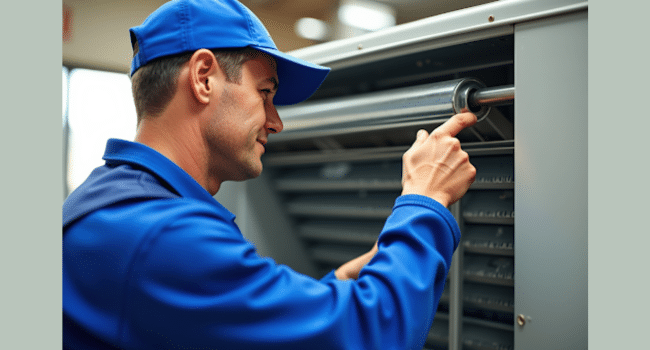Table of Contents
Your roller shutter serves as a critical component of your building’s security, weather protection, and operational efficiency. A failure can leave your assets, inventory, and personnel vulnerable. The costliest emergencies are often those that were preceded by subtle warnings. Ignoring these early signs leads to complete breakdowns, more extensive damage, and significantly higher repair bills.
1. Unusual Noises During Operation
A healthy roller shutter operates with a relatively smooth, consistent, and low hum. The moment you hear sounds that deviate from this norm, you should take notice. Grinding or metallic scraping sounds typically indicate that the internal mechanism or the rollers are grinding against the guide tracks.
The cause could be misaligned tracks, a lack of proper lubrication, or worn-out rollers. Continuous operation in this state will gouge the tracks and damage the rollers, leading to a seizure. Loud banging or knocking noises, especially at the start or end of a cycle, often point to a problem with the curtain itself.
A broken or bent slat may be catching and then snapping free. Whining or straining from the motor means it is under significant strain, which could be from friction in the system or an internal mechanical failure. Unaddressed, these noises will quickly escalate from a symptom to a direct cause of failure, destroying tracks, rollers, and the motor.
If you’re experiencing this problem, it’s crucial to contact a qualified repair specialist from a reputable company like Guardian Doors. Attempting a do-it-yourself (DIY) can be dangerous and may void your warranty. A trained technician can accurately diagnose the fault and perform a lasting repair, restoring your shutter’s function and your peace of mind.
2. Slow or Hesitant Movement
Your shutter’s speed should be consistent. A noticeable slowdown or a shutter that jerks and hesitates is signaling a problem. This is often a symptom of a failing motor that is losing its power.
However, it can also be caused by a faulty gearbox within the motor unit, a power supply issue delivering lower voltage, or a physical obstruction within the guide channels that is creating excessive friction. In spring-operated shutters, weakened springs can also cause slow, uncontrolled descent.
A slow motor is a straining motor. The increased electrical draw and heat generation will accelerate the wear on the motor’s components, leading to a complete burnout. Slowness is a precursor to stopping altogether and indicates a system that is on the brink of failure.
3. Visible Gaps, Warping, or Physical Damage
Check your shutter, whether sectional overhead doors or high-speed doors, in both the open and closed positions. If you see light through the closed shutter, your security is compromised. Gaps often stem from impacted slats, worn side seals, or misaligned guide rails that prevent the curtain from sitting flush.
Dents, bends, and warping from impacts weaken the door’s integrity. A bent slat can catch on adjacent slats or the guide rails, causing further damage with every cycle. On steel door sets, warping of the entire curtain indicates a serious structural issue.
In a corrosive environment, rust can eat away at the metal, thinning the slats and leading to tears. All visible damage directly compromises the door’s security and weather-tightness and will worsen. This underscores the importance of including inspections in your service contracts to ensure a swift response time for repairs.
4. The Shutter Stops Mid-Cycle
A door that stops randomly during operation is a critical sign of trouble. This is a primary symptom of a failing motor or a control system that is overheating or encountering excessive resistance.
Safety photocells (common on high-speed doors and sectional overhead doors) that are misaligned or dirty can also cause the door to stop and reverse. A faulty limit switch, which tells the motor when to stop, is another common cause.
A door stuck mid-cycle leaves your facility vulnerable. This is a direct operational failure that requires immediate diagnosis. For property owners, this is where the value of maintenance contracts becomes clear, as they typically prioritize emergency shutter repairs to restore security quickly.
5. Complete Failure to Respond
When your door completely fails to respond to the remote or wall control, it is an emergency. First, check for simple issues like a tripped breaker or a dead remote battery. If power is confirmed, the problem is severe.
A total lack of response typically indicates a catastrophic motor failure, a blown control board, or a significant break in the electrical wiring. Your security is now non-operational, and this situation demands an immediate emergency shutter repair call.
A fast response time is critical. Comprehensive service contracts are designed to cover this key scenario, providing property owners with guaranteed maintenance options and priority service to resolve such critical failures and restore the security of steel door sets and other door types without delay.

Bottom Line
Ignoring early warning signs like unusual noises, slow movement, or visible damage guarantees more disruptive and costly failures. Proactive maintenance is a strategic investment that prevents emergency shutdowns and preserves your security. Don’t wait for a complete breakdown. Schedule a professional inspection at the first symptom to ensure operational continuity, protect your assets, and avoid significantly higher repair bills.
